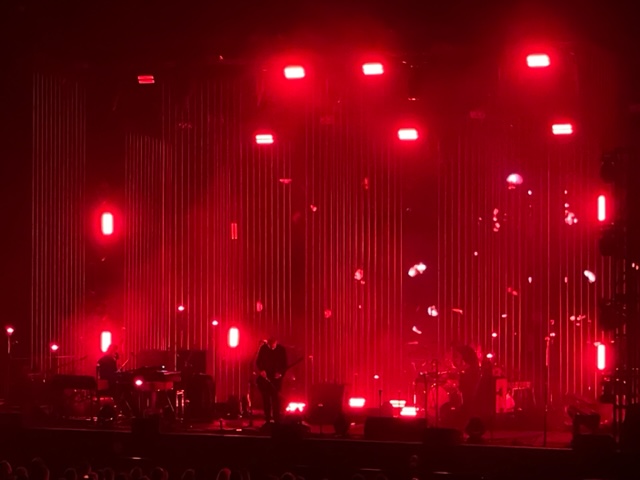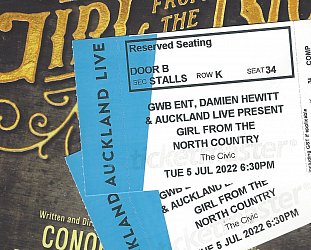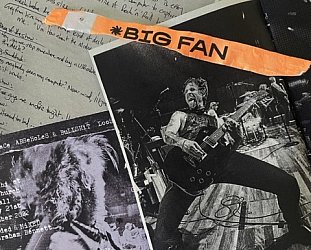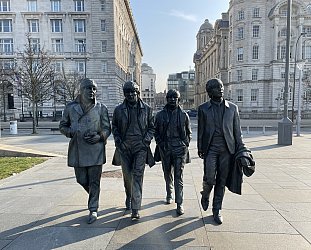Graham Reid | | 2 min read

Among the many remarkable things about the Icelandic band Sigur Ros is you can't understand a word they say in their songs because frontman Jonsi sings in Hopelandic (a made-up language) and his native Icelandic (spoken by fewer than 400,000).
Also of interest is, on the evidence of their concert at Auckland's Spark Arena, the four-piece were largely indifferent to their audience until the final 10 minutes when they engaged.
And by being cloaked in shadows for most of their set, unless you were in the front 10 rows and could see them clearly enough, they could stand beside you at the bus stop tomorrow and you wouldn't recognise them. They don't have their photos on album covers either.
Most interesting of all is that none of this troubled the large audience at all, an audience with a smattering of twentysomethings but mostly people 40-plus . . . the same people you might see at a concert by the Beths, Reb Fountain or Tami Neilson.
These are people who probably have a Radiohead album in their collection alongside Kind of Blue, something by the National and Brian Eno.
 Sigur Ros, now more than 25 years into their career, pull that kind of intelligent, attentive audience for their soundscapes where bowed electric guitar scrapes and sears in oceanic waves over drums, bass and keyboards.
Sigur Ros, now more than 25 years into their career, pull that kind of intelligent, attentive audience for their soundscapes where bowed electric guitar scrapes and sears in oceanic waves over drums, bass and keyboards.
They are the very definition of post-rock, yet another of those taxonomic devices which create a category for the inchoate diversity of music within it.
Post-rock – in a simple working description – is music made on rock instruments but which isn't rock.
Sigur Ros, in fact, deal even-handedly with pianistic minimalism and the kind of wall of guitar noise Neil Young conjures up with Crazy Horse. But with lyrics you can't understand.
It is remarkable to witness but also seems inexplicable on paper.
What we witness is the zenith of what Philip Glass called “crossover audiences” (as opposed to crossover albums or artists).
Here is an audience which is also post-rock in its own way: it has an appreciation of rock music and rock culture, but when it comes to groups like Sigur Ros, Tortoise and Radiohead, they aren't drawn by the notion of rock personality.
You'd never accuse Sigur Ros of having too much personality on stage, you get the impression that away from the lights they could live monastic lives for all we know.
 This audience may not be able to name the members of Sigur Ros or even readily identify their songs – there was some applause for the opening notes of Glosoli and Saeglopur (both from the Takk album and on the DVD/double live album Inni) among others – but that is incidental to the sheer pleasure taken in the sound of the group which can work from a few spare notes to a great caterwaul of sawing bow, thunderous drums and almost oppressive intensity.
This audience may not be able to name the members of Sigur Ros or even readily identify their songs – there was some applause for the opening notes of Glosoli and Saeglopur (both from the Takk album and on the DVD/double live album Inni) among others – but that is incidental to the sheer pleasure taken in the sound of the group which can work from a few spare notes to a great caterwaul of sawing bow, thunderous drums and almost oppressive intensity.
The concert was an aurally immersive experience which grew in intensity after the intermission when it most approached the maelstrom that noisy rock music can create.
So to some extent Sigur Ros present something akin to rock music, but rock without the thrust of personality or theatrics associated with a big concert.
This was more arthouse rock for an audience who understand PiL's early work, Neu! and David Bowie's Low and Heroes, and have the patience to sit and enjoy without whooping or bellicose behaviour.
Adult music for adults, in fact.
And it was remarkable.
.
Sigur Ros, Spark Arena, Auckland, New Zealand. August 6, 2022
Photos by Megan Stunzner.
.
Elsewhere tries to take a different approach to reviewing live concerts, often looking at the bigger picture or wider context rather just a setlist recount of the show.
You can find those in other forums
.






post a comment